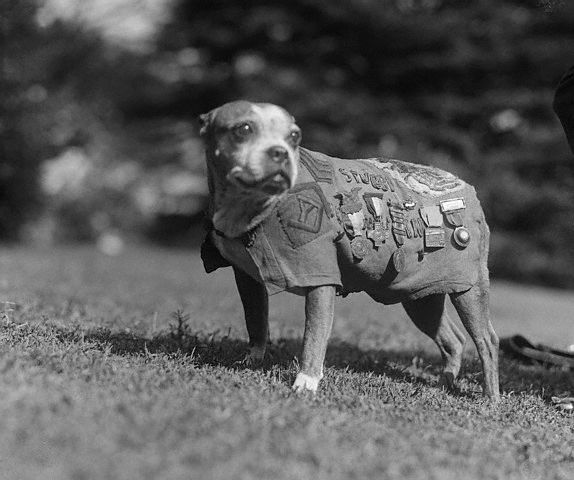Sergeant Stubby (1916 or 1917- March 16th 1926)
Dogs were a huge part of World War One across Europe, but the United States had a very difference approach to involving animals in the war effort. In fact, the only dogs that were utilised by America were the few belonging to the Allies.
Despite this, the United States can claim to have produced the most highly-decorated and celebrated dog of the first world war, and arguably in history.
Stubby, a bull terrier cross, started life as a stray who was eventually found wondering through an army training session at Yale Field in Connecticut. He became popular with all the soldiers, but it was Corporal Robert Conroy who became particularly fond of him, eventually naming him Stubby.
According to records made at the time, Conroy was so close to Stubby that, upon learning that he must ship out to the Western Front, he smuggled the terrier on bound the ship, which was bound for France. It wasn’t long before Stubby was discovered, but he was allowed to remain on board and soon found himself at the heart of World War One.
Stubby was allowed to remain with Conroy, who was a member of the 102nd Infantry, 26th “Yankee” Division, and was present at a number of battles including Chateau-Thierry, the Marne and St. Mihiel. Naturally, Stubby was injured during this time, being hit by shrapnel and gas attacks. However, he quickly recovered each time and was soon so well known that he was treated alongside humans in Red Cross hospitals.
As a result of the gas attacks, he soon became very sensitive to the smell of gas and was able to detect it significantly earlier than his human comrades. Soon he had learnt to indicate the presence of gas, as well as the sound of advancing enemy, and did so silently to avoid alerting the opposition. In one particular instance, he even detected the sound of a German spy, who had tried to sneak into Conroy’s camp during the night. Stubby, loyal to Conroy, grabbed the spy’s leg and prevented him from escaping until Conroy and his fellow troops were able to detain him.
Not content with simply alerting to gas and enemies, Stubby also learnt to scour the battlefield as a ‘mercy’ dog, searching for injured soldiers who needed medical attention or simply to be comforted as they died.
Stubby was so well-respected that, following the liberation of Chateau Thierry, he was named a hero and the women of the town made him a special chamois blanket on which his many medals and chevrons could be displayed. Even upon his return hime, Stubby was celebrated across the country and received more medals for his service than any other dog in history, even outranking his owner Conroy. In addition, Stubby was awarded a lifetime membership to the American Legion and was invited to take part in each and every march and convention until his death.
After returning home from the war, Stubby continued to live with Corporal Robert Conroy, who looked after him while studying law at Georgetown University.
Stubby eventually died in 1926. Despite his death being eight years after the end of the war, respect for him was still so high that he had an obituary written for him in the New York Times. It read as follows:
“On Feb. 5, 1918, he entered the front lines of the Chemin des Dames sector, north of Soissons, where he was under fire night and day for more than a month. The noise and strain that shattered the nerves of many of his comrades did not impair Stubby's spirits. Not because he was unconscious of danger. His angry howl while a battle raged and his mad canter from one part of the lines to another indicated realization. But he seemed to know that the greatest service he could render was comfort and cheerfulness.”
MLA Citation/Reference
"Sergeant Stubby (1916 or 1917- March 16th 1926)". HistoryLearning.com. 2025. Web.

